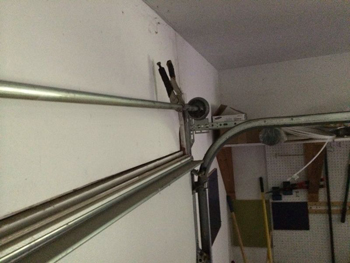 Most of today’s residential garage doors use a single torsion spring. The component works to counterbalance the door and to provide the force necessary for proper opening. Hence, the spring’s length, inside diameter and wire size should be chosen to match the unit’s weight. Generally, a bigger wire size will also make the component more durable. Based on make, there are two types of torsion springs. The galvanized steel components are the most widely used. They are resistant to rust and corrosion and require lubrication maintenance at least a year. The oil tempered springs are best suited for heavier doors which are used many times during the day. Their coils are covered with oil so there is no need for lubrication, but they may leave residue on the panels. The average torsion spring has a cycle life of 10,000 cycles, but there are models that can perform 15,000 and even 20,000 cycles before breaking.
Most of today’s residential garage doors use a single torsion spring. The component works to counterbalance the door and to provide the force necessary for proper opening. Hence, the spring’s length, inside diameter and wire size should be chosen to match the unit’s weight. Generally, a bigger wire size will also make the component more durable. Based on make, there are two types of torsion springs. The galvanized steel components are the most widely used. They are resistant to rust and corrosion and require lubrication maintenance at least a year. The oil tempered springs are best suited for heavier doors which are used many times during the day. Their coils are covered with oil so there is no need for lubrication, but they may leave residue on the panels. The average torsion spring has a cycle life of 10,000 cycles, but there are models that can perform 15,000 and even 20,000 cycles before breaking.
What Extension Springs Offer
These are used in pairs - there is one spring on each side of the door mounted above the respective horizontal track. These springs are extended and hold energy to counterbalance the door when the unit is in closed position. They contract to release this energy during opening in order to facilitate the process. These components are smaller compared to their torsion counterparts and the amount of energy which they hold cannot be adjusted through winding and unwinding. They don’t require lubrication maintenance to work well, but their coils are at greater risk of deformation. Their average cycle life is 5,000 cycles, but some models can perform 10,000 cycles.